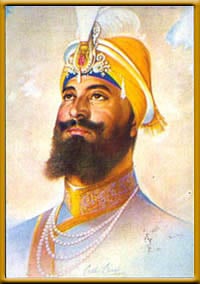Why I wear a Turban?: Difference between revisions
Allenwalla (talk | contribs) mNo edit summary |
Allenwalla (talk | contribs) (some restructuring) |
||
| (7 intermediate revisions by 2 users not shown) | |||
| Line 1: | Line 1: | ||
{{fa|109}} | |||
[[Image:Guru Gobind Singh 1.jpg|thumb|200px|right|{{Cs|'''[[Guru Gobind Singh]]'''}}]] | [[Image:Guru Gobind Singh 1.jpg|thumb|200px|right|{{Cs|'''[[Guru Gobind Singh]]'''}}]] | ||
Most people outside of Asia and the Middle East who wear a [[turban]] are [[Sikh]]s. Male Sikhs who have taken Amrit or [[Pahul]] and added the name [[Singh]], are required to don the [[Dastaar]] due to a pronouncement in 1699 by the tenth Sikh master [[Guru Gobind Singh]]. Dastaar, is the native [[Punjabi]] word used to refer to this head dress. Even some Sikh women, who are not required to wear a turban do so after taking Amrit and gaining the name [[Kaur]]. Even today some 300 years later, it is in compliance to the [[Hukam]] (or order) of the last Sikh human Guru that all Singhs today wear the [[dastaar]]. It is in honour and obedience to this one person! | Most people outside of Asia and the Middle East who wear a [[turban]] are [[Sikh]]s. Male Sikhs who have taken Amrit or [[Pahul]] and added the name [[Singh]], are required to don the [[Dastaar]] due to a pronouncement in 1699 by the tenth Sikh master [[Guru Gobind Singh]]. Dastaar, is the native [[Punjabi]] word used to refer to this head dress. Even some Sikh women, who are not required to wear a turban do so after taking Amrit and gaining the name [[Kaur]]. Even today some 300 years later, it is in compliance to the [[Hukam]] (or order) of the last Sikh human Guru that all Singhs today wear the [[dastaar]]. It is in honour and obedience to this one person! | ||
Though Sikh boys (and girls) are not technically born 'a Baptised Sikh' (they must freely choose to be an Amrithari in the same manner that Protestant children must choose to be Baptisted) they, most likely, will be raised wearing a [[Patka]] due to the respect | Though Sikh boys (and girls) are not technically born 'a Baptised Sikh' (they must freely choose to be an Amrithari in the same manner that Protestant children must choose to be Baptisted) they, most likely, will be raised wearing a [[Patka]] due to the respect that their parents have for Guru Gobind Singh. | ||
The Prime Minister of [[India]], [[Dr. Manmohan Singh]] a Sikh, wears his sky blue turban (now a personal trademark) out of respect for the tenth [[Sikh Guru]]; the famous record breaking, 95-year-old marathon runner, [[Fauja Singh]] proudly wears his [[dastaar]] in honour of the tenth Sikh teacher; [[Bhagat Puran Singh]] the humble humanist and philanthropist donned a simple [[turban]] in respect of Guru Gobind Singh. Why do Sikhs go to all this trouble so many years after his dictate? | The Prime Minister of [[India]], [[Dr Manmohan Singh|Dr. Manmohan Singh]] a Sikh, wears his sky blue turban (now a personal trademark) out of respect for the tenth [[Sikh Guru]]; the famous record breaking, 95-year-old marathon runner, [[Fauja Singh]] proudly wears his [[dastaar]] in honour of the tenth Sikh teacher; [[Bhagat Puran Singh]] the humble humanist and philanthropist donned a simple [[turban]] in respect of Guru Gobind Singh. Why do Sikhs go to all this trouble so many years after his dictate? | ||
[[Image:DrManmohanSingh.jpg|thumb|200px|left|{{Cs|'''[[Dr Manmohan Singh]], PM of India'''}}]] | [[Image:DrManmohanSingh.jpg|thumb|200px|left|{{Cs|'''[[Dr Manmohan Singh]], PM of India'''}}]] | ||
==A gruesome, barbaric act== | |||
If you know little about [[Sikh history]] and Sikh traditions, the story that follows will be a revelation and a real eye opener – maybe even a total surprise. | |||
[[ | In 1675, in [[old Delhi]]'s {{Wiki|Chandni Chowk}} (the city's most public place) a most horrific event took place, an event that changed the course of, not only Sikh history, but of [[Indian]] history, as well. In front of the [[Laal Kila]] on the orders of the Mughal Emperor [[Aurangzeb]] - the pious and benevolent leader of the Sikhs, [[Guru Tegh Bahadur]] was beheaded, after several days of torture. | ||
[[Image:FaujaSingh.jpg|thumb|200px|right|{{Cs|'''[[Fauja Singh|Bhai Fauja Singh]], Record breaking Marathon runner'''}}]] | |||
The Guru had challenged the mighty Emperor on behalf of a Group of Hindu Pandits who had been told to convert to Islam or die. The Guru had had hoped to end the savage way the Hindus were being treated by showing Aurangzeb the folly of his 'Godless ways.' Rather than heading to entreaties of the august Guru Tegh BahadurAfter offers of worldly power failed in converting the Guru. The Emperor had three of the Guru's devotees (Sikhs) tortured to death, each in a hideously different way, in front of the Guru's eyes. Then he was asked to perform a miracle (against the Guru's beliefs) finally, after failing to submit to Islam and renounce his faith the 9th Guru was executed. It is recounted that the ground shook and the winds roared as a mighty sandstorm overtook Delhi. Was it a display of anger at such a traumatic event – against a most saintly and loving soul. | |||
When the Guru's young son [[Guru Gobind Rai]] to whom his Saintly father had passed the Guruship before his departure for the Emperor's Darbar, found out about the tragic death of his father, he asked [[Bhai Jaita|Bhai Jivan]], a witness of the event: "Wasn't there any Sikh in the crowd" – meaning wasn't there any brave people in the crowd who would have stopped such a tragedy from taking place. The answer that he received led to the Guru's eventual gift of the [[dastaar]] as part of the [[Articles of faith|5 Kakkars]] which would change the outward appearance of Sikhs so that they would be sure to stand out in any future crowd as an island of hope for anyone in trouble. | |||
[[ | |||
Bhai Jivan replied, "Guru Ji, many Sikhs must have been there in the crowd, but they could not be recognised." You see, in 1675, the Sikhs were not required to wear a turban. All the Sikh Gurus had worn [[turban|turbans]] but not all of their followers ([[Sikhs]]) did. | |||
[[Image:Bhagat Puran Singh M.jpg|thumb|200px|left|{{Cs|'''[[Bhagat Puran Singh]], World recognised humanist'''}}]] | [[Image:Bhagat Puran Singh M.jpg|thumb|200px|left|{{Cs|'''[[Bhagat Puran Singh]], World recognised humanist'''}}]] | ||
[[Guru Gobind Rai]] said, "Bhai | [[Guru Gobind Rai]] said, "Bhai Jivan ji, I will create the [[Khalsa]], who will stand out in the crowd and who will never flinch from performing their duties whatever the odds." | ||
Over the next 24 years, the [[Guru]] prepared the Sikhs to reach a high level of consciousness; to become brave and strong; to love truth and [[dharma]] more than pleasure and materialist gain. Then in 1699, he announced: "Saava lakh say ek laarrau, tabh Gobind Singh namh kaahaoo" – "When one will stand and fight 125,000, then I shall be called Gobind Singh." In those 24 years he transformed a passive, feeble and subservient people of [[India]] into a brave and fearless warrior people who were extremely courageous and valiant but at the same time were compassionate and just – a real [[Sant Sipahi]] - a "warrior saint". | Over the next 24 years, the [[Guru]] prepared the Sikhs to reach a high level of consciousness; to become brave and strong; to love truth and [[dharma]] more than pleasure and materialist gain. Then in 1699, he announced: "Saava lakh say ek laarrau, tabh Gobind Singh namh kaahaoo" – "When one will stand and fight 125,000, then I shall be called Gobind Singh." In those 24 years he transformed a passive, feeble and subservient people of [[India]] into a brave and fearless warrior people who were extremely courageous and valiant but at the same time were compassionate and just – a real [[Sant Sipahi]] - a "warrior saint". | ||
His father Guru Tegh Bahadur had sacrificed his live in | His father Guru Tegh Bahadur had sacrificed his live in 1675 in the cause of the [[Dharam|path of righteousness]] when young Gobind Rai was only nine. From that day onwards, [[Guru Gobind Singh]] led 'from the front' and taught the Sikhs how to master their balance of saintliness and gallantry; how to be compassionate and to fight for the weak; to be strong but humble. In the days after the betrayal at Anandpur and the broken oaths of the Pahari Rajas (the hill chiefs) and their Mughal overlords the Guru would lose his mother and his four sons as they sacrificed their lives in the cause of righteousness, choosing death in their fight against evil. Though the loss of his family must have weighed heavily on his heart the Guru never failed in showing his people how to follow the [[Dharam|path of righteousness]]. He never wavered in his belief in truth and honesty right to the end. | ||
Though most of his family was lost; his two eldest, teenage, sons martyred in battle; [[Sahibzada|his two youngest sons]] martyred as they refused to bow to Islam; his aged, weakened and starved mother dying as she heard of her two grandchildren's tortured death, the 10th Guru's spirit was never defeated. He remembered God, even when all wealth was gone; he barely had clothes on his back; most of his companions had perished in battle – what did he say to God | Though most of his family was lost; his two eldest, teenage, sons martyred in battle; [[Sahibzada|his two youngest sons]] martyred as they refused to bow to Islam; his aged, weakened and starved mother dying as she heard of her two grandchildren's tortured death, the 10th Guru's spirit was never defeated. He remembered God, even when all wealth was gone; he barely had clothes on his back; most of his companions had perished in battle – what did he say to God? | ||
:'''"God, I am not happy with you. I have never done anything wrong. Why are you punishing me like this?"''' – Most definitely not! | |||
[[Image:JJ SIngh 1.jpg|thumb|200px|right|{{C|'''[[General JJ Singh]], Chief of Indian Army'''}}]] | [[Image:JJ SIngh 1.jpg|thumb|200px|right|{{C|'''[[General JJ Singh]], Chief of Indian Army'''}}]] | ||
| Line 54: | Line 51: | ||
Remembering the Lord is more important than all the wealth and all relationships in the world! [[G10|Guru Gobind Singh's]] contribution to the world has been undeniable and proof of that lies in the accomplishments of millions of Sikhs who everyday wear his token on their head; to honour his life and remember the wonderful example that he set for the rest of us. May his memory live forever! [[Waheguru]]. | Remembering the Lord is more important than all the wealth and all relationships in the world! [[G10|Guru Gobind Singh's]] contribution to the world has been undeniable and proof of that lies in the accomplishments of millions of Sikhs who everyday wear his token on their head; to honour his life and remember the wonderful example that he set for the rest of us. May his memory live forever! [[Waheguru]]. | ||
==The unique style of the Sikh Dastaar== | |||
[[Dastaar|Dastaars]] come in many different colours and styles and, to the keen eye, each [[turban]] is different. Some are simple but regal; others may be bright and sporty; yet others may be stylish and extravagant – each one has its own special and unique statement. Every morning, most Sikh men and many Sikh women, spend some 5 to 20 minutes to comb their long hair and then carefully handcraft their Dastaar—the link to their [[Gurus]] – a daily reminder of their heritage and its responsibilities. What begins as a simple 4 to 8 metres of plain coloured cloth is then transformed into a statement. Each person is instantly elevated and recognised as being 'different'. | |||
While the messages emanating from this simple piece of coloured cloth may vary from day to day depending on the the individual and his creativity, the reason for and purpose behind this simple religious garment is a message which never varies for it is an extremely serious message. | |||
[[Category:Sikh belief]] | [[Category:Sikh belief]] | ||
Latest revision as of 20:05, 26 October 2010
Most people outside of Asia and the Middle East who wear a turban are Sikhs. Male Sikhs who have taken Amrit or Pahul and added the name Singh, are required to don the Dastaar due to a pronouncement in 1699 by the tenth Sikh master Guru Gobind Singh. Dastaar, is the native Punjabi word used to refer to this head dress. Even some Sikh women, who are not required to wear a turban do so after taking Amrit and gaining the name Kaur. Even today some 300 years later, it is in compliance to the Hukam (or order) of the last Sikh human Guru that all Singhs today wear the dastaar. It is in honour and obedience to this one person!
Though Sikh boys (and girls) are not technically born 'a Baptised Sikh' (they must freely choose to be an Amrithari in the same manner that Protestant children must choose to be Baptisted) they, most likely, will be raised wearing a Patka due to the respect that their parents have for Guru Gobind Singh.
The Prime Minister of India, Dr. Manmohan Singh a Sikh, wears his sky blue turban (now a personal trademark) out of respect for the tenth Sikh Guru; the famous record breaking, 95-year-old marathon runner, Fauja Singh proudly wears his dastaar in honour of the tenth Sikh teacher; Bhagat Puran Singh the humble humanist and philanthropist donned a simple turban in respect of Guru Gobind Singh. Why do Sikhs go to all this trouble so many years after his dictate?
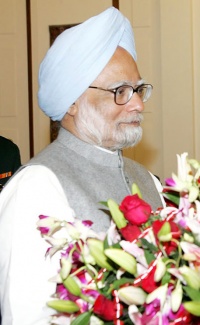
A gruesome, barbaric act
If you know little about Sikh history and Sikh traditions, the story that follows will be a revelation and a real eye opener – maybe even a total surprise.
In 1675, in old Delhi's Chandni Chowk (the city's most public place) a most horrific event took place, an event that changed the course of, not only Sikh history, but of Indian history, as well. In front of the Laal Kila on the orders of the Mughal Emperor Aurangzeb - the pious and benevolent leader of the Sikhs, Guru Tegh Bahadur was beheaded, after several days of torture.
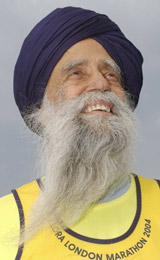
The Guru had challenged the mighty Emperor on behalf of a Group of Hindu Pandits who had been told to convert to Islam or die. The Guru had had hoped to end the savage way the Hindus were being treated by showing Aurangzeb the folly of his 'Godless ways.' Rather than heading to entreaties of the august Guru Tegh BahadurAfter offers of worldly power failed in converting the Guru. The Emperor had three of the Guru's devotees (Sikhs) tortured to death, each in a hideously different way, in front of the Guru's eyes. Then he was asked to perform a miracle (against the Guru's beliefs) finally, after failing to submit to Islam and renounce his faith the 9th Guru was executed. It is recounted that the ground shook and the winds roared as a mighty sandstorm overtook Delhi. Was it a display of anger at such a traumatic event – against a most saintly and loving soul.
When the Guru's young son Guru Gobind Rai to whom his Saintly father had passed the Guruship before his departure for the Emperor's Darbar, found out about the tragic death of his father, he asked Bhai Jivan, a witness of the event: "Wasn't there any Sikh in the crowd" – meaning wasn't there any brave people in the crowd who would have stopped such a tragedy from taking place. The answer that he received led to the Guru's eventual gift of the dastaar as part of the 5 Kakkars which would change the outward appearance of Sikhs so that they would be sure to stand out in any future crowd as an island of hope for anyone in trouble.
Bhai Jivan replied, "Guru Ji, many Sikhs must have been there in the crowd, but they could not be recognised." You see, in 1675, the Sikhs were not required to wear a turban. All the Sikh Gurus had worn turbans but not all of their followers (Sikhs) did.
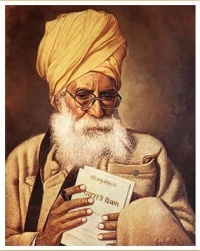
Guru Gobind Rai said, "Bhai Jivan ji, I will create the Khalsa, who will stand out in the crowd and who will never flinch from performing their duties whatever the odds."
Over the next 24 years, the Guru prepared the Sikhs to reach a high level of consciousness; to become brave and strong; to love truth and dharma more than pleasure and materialist gain. Then in 1699, he announced: "Saava lakh say ek laarrau, tabh Gobind Singh namh kaahaoo" – "When one will stand and fight 125,000, then I shall be called Gobind Singh." In those 24 years he transformed a passive, feeble and subservient people of India into a brave and fearless warrior people who were extremely courageous and valiant but at the same time were compassionate and just – a real Sant Sipahi - a "warrior saint".
His father Guru Tegh Bahadur had sacrificed his live in 1675 in the cause of the path of righteousness when young Gobind Rai was only nine. From that day onwards, Guru Gobind Singh led 'from the front' and taught the Sikhs how to master their balance of saintliness and gallantry; how to be compassionate and to fight for the weak; to be strong but humble. In the days after the betrayal at Anandpur and the broken oaths of the Pahari Rajas (the hill chiefs) and their Mughal overlords the Guru would lose his mother and his four sons as they sacrificed their lives in the cause of righteousness, choosing death in their fight against evil. Though the loss of his family must have weighed heavily on his heart the Guru never failed in showing his people how to follow the path of righteousness. He never wavered in his belief in truth and honesty right to the end.
Though most of his family was lost; his two eldest, teenage, sons martyred in battle; his two youngest sons martyred as they refused to bow to Islam; his aged, weakened and starved mother dying as she heard of her two grandchildren's tortured death, the 10th Guru's spirit was never defeated. He remembered God, even when all wealth was gone; he barely had clothes on his back; most of his companions had perished in battle – what did he say to God?
- "God, I am not happy with you. I have never done anything wrong. Why are you punishing me like this?" – Most definitely not!
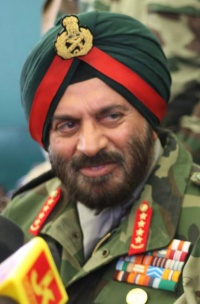
This is the actual Shabad which he sang at the time:
| ਮਿਤਰ ਪਿਆਰੇ ਨੂੰ ਹਾਲ ਮਰੀਦਾ ਦਾ ਕਹਿਣਾ ॥
ਤਧ ਬਿਨ ਰੋਗ ਰਜਾਈਆ ਦਾ ਓਢਣ ਨਾਗ ਨਿਵਾਸਾ ਦੇ ਹਹਿਣਾ ॥ ਸੂਲ ਸਰਾਹੀ ਖੰਜਰ ਪਿਆਲਾ ਬਿੰਗ ਕਸਾਈਆਂ ਦਾ ਸਹਿਣਾ ॥ ਯਾਰੜੇ ਦਾ ਸਾਨੂੰ ਸੱਥਰ ਚੰਗਾ ਭਠ ਖੇੜਿਆ ਦਾ ਰਹਿਣਾ ॥ |
| mithr piaarae noo(n) haal mureedhaa dhaa kehinaa ॥ thudhh bin rog rajaaeeaa dhaa oudtan naag nivaasaa dhae hehinaa ॥ |
| Please tell my dear friend (God) the plight of his disciples.
Without You, comfort of rich blankets is a disease; living in a home is like living with snakes. Our water pitchers are like torturous stakes and our cups have edges like daggers. Neglecting You, is like the suffering of animals at the hands of butchers. My Beloved's straw bed is more pleasing than living in costly furnace-like mansions. |
Remembering the Lord is more important than all the wealth and all relationships in the world! Guru Gobind Singh's contribution to the world has been undeniable and proof of that lies in the accomplishments of millions of Sikhs who everyday wear his token on their head; to honour his life and remember the wonderful example that he set for the rest of us. May his memory live forever! Waheguru.
The unique style of the Sikh Dastaar
Dastaars come in many different colours and styles and, to the keen eye, each turban is different. Some are simple but regal; others may be bright and sporty; yet others may be stylish and extravagant – each one has its own special and unique statement. Every morning, most Sikh men and many Sikh women, spend some 5 to 20 minutes to comb their long hair and then carefully handcraft their Dastaar—the link to their Gurus – a daily reminder of their heritage and its responsibilities. What begins as a simple 4 to 8 metres of plain coloured cloth is then transformed into a statement. Each person is instantly elevated and recognised as being 'different'.
While the messages emanating from this simple piece of coloured cloth may vary from day to day depending on the the individual and his creativity, the reason for and purpose behind this simple religious garment is a message which never varies for it is an extremely serious message.
